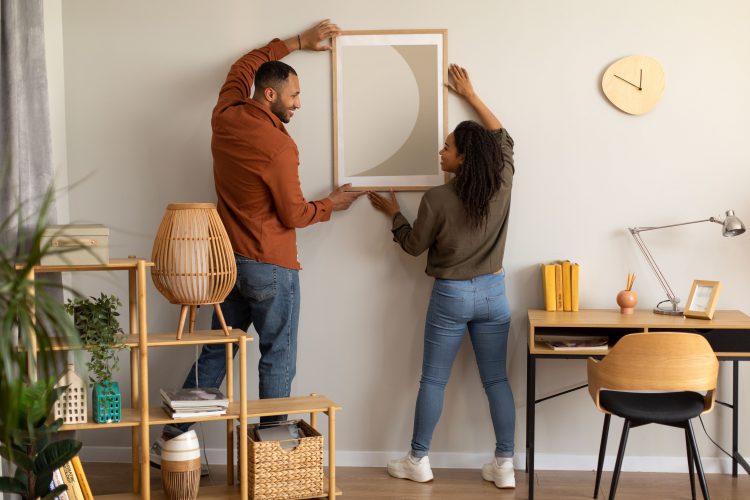Do you ever wish someone would come in and tell you exactly what to do in every room of your house? Consider this guide your blueprint to doing just that. Read on for your room-by-room decorating manual.
Bedroom
A bedroom should be a place of solace, rest and relaxation. Its creation should be intentional, focused on function and complemented by a soft, calming aesthetic.
- Eliminate clutter: A bedroom retreat should be a serene and calm space, which you can accomplish by starting with a blank canvas. Before bringing in anything new, remove clutter from surfaces and corners.
- Create the layout: Space planning will help you create the best layout to maximize space, comfort and relaxation. The bed, rug, bedside tables, dressers, other storage pieces, seating options and wall decor should all be considered as you design the floor plan.
- Select a color palette: The room’s color scheme will create a cohesive look. The 60-30-10 rule is a tried-and-true way to achieve a harmonious color palette ( 60% of the room should be the primary color, 30% should be a secondary color, and 10% should be an accent color).
- Add something soft underfoot: One of the most essential qualities of a relaxing bedroom is softness, so be sure the rug is large enough to extend beyond both sides of the bed.
- Layer the window treatments: Creating an optimal sleep environment starts with a dark room. Blackout shades or curtains will block the light and be a design element.
- Choose lighting: Various types of lighting will add ambiance and create a soothing space. A statement piece, such as a chandelier, sconces or table lamp, will let you control the level of lighting you want.
Home Office
A home office should help you feel inspired, calm and empowered. Turning your home office into a space where you want to retreat can transform it from a space where you watch the clock to a room that feels like your own oasis.
- Select lighting: Sunlight is a natural mood booster, which can be necessary during long work days. Ensuring ample sunlight can come through the windows will boost energy and even help you concentrate better. A mix of desk lamps, floor lamps, sconces and art lights can let you control the lighting level depending on the time of day and the type of project you’re working on.
- Reimagine the furniture: A traditional desk doesn’t always need to be included in a home office. For example, a round dining table instead of a desk creates an elegant look and a more flexible space. If you prefer to be more comfortable during long days of calls and spreadsheets, having a place to lounge, such as a sofa or a chaise lounge, may be best for you.
- Have a video call background: If you spend your day on video calls, creating a background can highlight your professional brand. Wallpapering a wall in your home office, having the correct lighting in place and styling bookcases to showcase the items that represent your best self will help you appear more professional.
- Include ample storage: Open shelving is perfect for displaying items that reflect your interests that may not otherwise have a space within your home. Alternatively, closed shelving is ideal for files, folders and other miscellaneous items.
- Add soundproof accents: Soundproofing your office can help reduce outside distractions. Wall-to-wall carpeting, layering rugs, installing draperies and hanging framed art and photographs are all ways to muffle sounds.
Living Room
A living room’s layout, colors, style, lighting, accessories and more are all essential factors in creating a thoughtfully designed gathering, hosting and relaxing space.
- Determine the function: Whether it’s a space for the family to gather for movie nights, a room to entertain guests or an area to play and relax, establishing the function of the space is the foundation for how the whole room will come together.
- Create the layout: Space planning will help you create a functional and helpful layout that maximizes the space. Thorough measurements of the room will help you assess where the furniture should go, how large the rug should be, where to hang art and other design decisions.
- Select the furniture: The best starting points are the rug and the sofa. The rug can help set the aesthetic for the room, and the sofa is typically the largest and most significant piece of furniture. Once those two primary pieces are selected, you can choose additional seating, tables and accent pieces.
- Layer in lighting: Every room should have a variety of lighting, including ambient, task and accent lighting. This could blend overhead lighting, table and floor lamps and wall sconces.
- Accessorize the room: Accessorizing the room is the final step. The most interesting spaces combine personal items, meaningful art, subtle family photographs and accessories collected over time.
Dining Room
A formal dining room can be the most beautiful room in the home. However, you may only use it several times a year. Rethinking how you use this space can be the key to making it more functional.
- Make it casual: If you host sit-down meals semi-regularly and want to keep your dining room, you can make the room more approachable and casual for a space you use more often, even gathering around the table for weeknight dinners.
- Design an office: The furniture should be multifunctional, with your dining room being an office by day and a dining room by night. The dining table can turn into a desk, with the correct desk chair, computer, table lamp and other workday necessities. Installing built-ins or mobile storage can easily conceal your workday essentials after the workday is over. When it’s time to set the table, you can easily reposition the dining chairs, tuck away your workday items, drape the tablecloth, set the tablescape and watch this room transform into an entertaining destination.
- Set up a game room: For the household that loves gathering to play your favorite games, setting up several game tables instead of a dining room can create a space for family game nights or even larger game nights when you host friends and family. Use the same chairs at the different game tables for a cohesive look and to seamlessly transition these chairs to dining chairs. If you need to use the space for a dining room, you can push the tables together, drape a tablecloth, set up the chairs and it will look like a complete dining set.
- Create a cocktail lounge: If you prefer swanky sips over a sit-down supper, transform your dining room into a cocktail lounge. Envelop the space in a moody, dark paint color and dark, textured wallpaper. Sleek yet comfortable seating and soft, warm lighting will create a space where you can entertain or escape during a quiet night at home.











